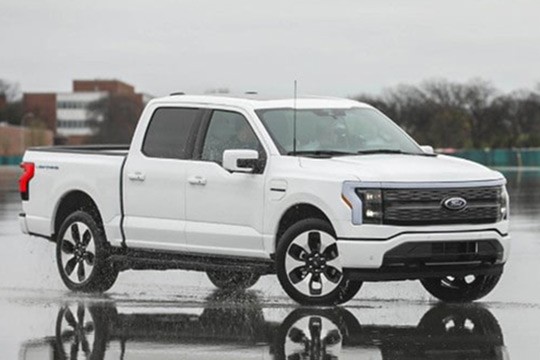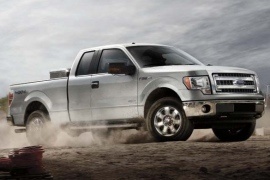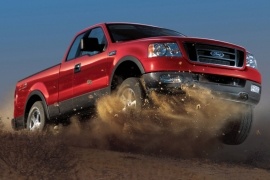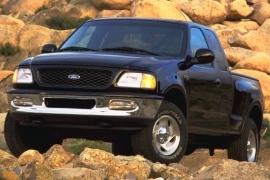FORD F-150 Super Cab Models/Series Timeline, Specifications & Photos
First production year: 2001
Engines: Electric, Gasoline,
Body style: Truck
Ford introduced the electric version of its best-selling truck F-150 in 2022 and took a different approach than its main competitors, such as the Chevrolet Silverado EV or the Rivian R1T.
The F series was the best-selling model in the car industry, and Ford was proud of it. And yet, it didn't rush to create an electric version for it and waited until it was sure that it could provide a trustworthy work truck.
While it shared most body panels with the version powered by an internal combustion engine, the F-150 Lightning featured a few particular differences. At the front, the massive grille between the headlights was completely blocked. Since there was no radiator behind it, it didn't make sense to have an actual grille. Instead, it was a panel with a horizontal sculptured slat in the middle that sported the blue-oval badge. The headlights were visually united via an LED strip that served as a daytime running light. From its sides, though, the pickup looked very similar to the rest of the F-150 range, with the two-step window line and the separated bed at the back.
On the inside, the most significant change was for the infotainment screen. Ford installed a portrait-mode, massive 15.5" touchscreen in the middle of the dashboard, replacing the regular center stack. Moreover, a 12" instrument panel sat in front of the driver. Another major difference from the regular F-150 was the front trunk. Since it didn't have an engine there, Ford installed a 400 liters (14 cu-ft) luggage compartment ideal for groceries. In the same area, the carmaker placed four 110 V outlets to power various equipment on a construction site, for instance.
The F-150 was available with two battery packs and a choice of two engines. In the most potent version, it provided a neck-hurting four-second acceleration from 0 to 60 mph (0-97 kph).
Ford introduced another update for the twelfth generation of the F-150 in 2012, changes that had a significant difference for the SuperCab version of this model.
The F-150 was the best-selling nameplate in the automotive industry, and Ford tried to keep that crown by offering the pickup in more cab versions and trim levels. Thus, it could be a very appropriate vehicle for constructors, contractors, entrepreneurs, country singers, and so on. The SuperCab version was not exactly the kind of vehicle that could fit in all areas, but it was useful in a construction site. That’s why the 2012 model year focused on that more than on other things.
At the front, the SuperCab featured a grille with three horizontal slats, which, depending on the grade, were chromed. The headlights remained similarly shaped as those from the 2009 model year but with restyled turn signals on the corners. From its profile, the enlarged front fenders ensured customers that the big wheels wouldn’t damage the vehicle and would protect the bodywork from mud and dirt in unpaved areas. A set of side steps was offered as an option, and they also served as rock-sliders. Unlike its siblings, the SuperCab came with front-hinged doors for the front passengers and rear-hinged half-doors for those seated in the back. Starting with the 2012 model year, the F-150 SuperCab came with an 8 ft (244 cm) long bed behind the cabin and no heavy-duty suspension for it. The bed was long enough to fit a sheet of plywood in it, thanks to the distance between the inner panels. In addition, Ford offered an option for a special coating that protected the bed from scratches and dents.
The interior of the SuperCab was similar to its predecessor, featuring two bucket seats at the front, with the front occupants separated by a wide center console. As an option, customers could get a bench seat for three there, with a flat folding center armrest fitted with two cup holders that occupied the middle seat when it wasn’t needed. The plastic dashboard and chunky buttons and dials ensured customers that they could use them with gloves on. In front of the driver, the automaker installed an analog instrument cluster and a TFT display between the tachometer and speedometer. In the back, the jump-seat bench could be lifted for additional storage if they were not needed. Even though there was not too much legroom there, it was wide enough for short trips in and around town or perfectly suitable for children.
Under the hood, Ford installed a wide choice of gasoline engines, ranging between a 3.7-liter, naturally-aspirated V6 and a newly introduced 3.6-liter EcoBoost sporting the same cylinder layout. All versions were paired with a six-speed automatic gearbox. Depending on the trim and options, customers could get the F-150 SuperCab with either rear or 4x4 systems.
Over 1000 engineers worked on the twelfth generation of the F-150 to help the best-selling nameplate in automotive history stay on top of its game, despite the world financial crisis.
Developed in 35 versions, the F-150 offered something for everyone. From the rancher in Texas to the contractor in Florida, a version could suit any job. But, most importantly, it could serve as a family car as well.
While the Regular Cab was the family's workhorse, the Super Cab sat between that and the Super Crew. It still featured four doors, but unlike its bigger sibling, it had rear-hinged doors for the passengers who sat in the back. But, depending on the budget, it could provide a flashy appearance with its three-slat chromed grille at the front and the stepped line over the front doors.
Inside, the Super Cab provided all the comfort for the front passengers, thanks to its wide seats. A massive center console, which served as a storage area and hosted the gear lever, divided the cabin in two. A complete instrument cluster fitted with two large dials and four small gauges provided the necessary information for the driver. In addition, an LCD sat between the speedometer and tachometer, showing more data from the on-board computer.
Like its siblings, the Super Cab featured a hydroformed chassis designed for endurance and heavy punishments on rough terrain and heavy loads. Ford offered two vehicle lengths, depending on the box size in the back, which came in three sizes. Under the hood, the carmaker installed a choice of three V8 engines, which provided between 248 hp and 320 hp. The six-speed automatic gearbox was standard on the entire range.
FORD F-150 Super Cab 4.6L (248 HP) (5.5 ft. bed)
FORD F-150 Super Cab 4.6L (248 HP) (6.5 ft. bed)
FORD F-150 Super Cab 4.6L (292 HP) (5.5 ft. bed)
FORD F-150 Super Cab 4.6L (292 HP) (6.5 ft. bed)
FORD F-150 Super Cab 5.4L (320 HP) (5.5 ft. bed)
Ford introduced the eleventh generation of the F-150 in 2003 as a 2004 model with a choice of cabins and beds.
The Ford F-150 represents one of the most important vehicles in the American carmaker lineup. By 2003, it was evident that it had to keep its standards and continuously improved the most notorious pickup-truck. Along with the new generation, Ford introduced some stylistic changes that made the vehicle unique on the market.
For the Super Cab version, Ford installed a longer cabin with a set of suicide-doors (rear-hinged) in the back. Thus, it made room for easier access to the backbench, which was fit for three adult passengers. It didn't offer too much legroom, but it was more than enough for short or medium trips. Ford introduced the dipped-down front side of the door-windows on the eleventh generation, like the Ford Super Duty series. The carmaker offered the F150 with a regular or extended bed. The former was mostly used for off-road enthusiasts. In the 4x4 version, the F150 sported closed-loop tow hooks at the front.
Inside, there was a car-like interior, with a wide center stalk and silver trims. The wide center console featured cup-holders good enough for a big-gulp pop can. Ford re-arranged the dials on the instrument cluster and placed the small gauges for fuel-level, coolant-temperature, ammeter, and oil pressure between the big speedometer and tachometer. The user could have lifted the rear bench and get more storage space on the floor.
Under the hood, Ford installed a choice of three gasoline engines that provided between 202 hp and 300 hp. It was available with rear- or all-wheel-drive.
The F150 reached its tenth generation in 1997. Still, the blue-oval brand's marketing department found a niche on the market and introduced an extended version for the Regular Cab version: the 2001 Super Cab.
By 2001, Ford F-Series was already the most produced nameplate in the world. After millions of units produced and different evolution in its lineup, Ford F-150 came on the market with a new approach, which allowed it to offer roomier interiors and still carry heavy loads, not to mention towing capabilities.
The 2001 F-150 didn't look as rough as some other pickups on the market. Its rounded edges and smoother design for the headlights might sound like a softening for the rugged pickup. The Super Cab version featured four doors with rear-hinged rear doors. In the back, the bed was big enough for most of the loads and, if there was a need for something more, the car could tow up to 8000 lbs (3628 kg) in a 2WD version.
The customers used the Super Cab mostly as a workhorse since it could carry two extra people in the back when needed. Other than that, that area was useful as a storage area for fishing rods or camping equipment.
Under the hood, Ford installed some of the powerplants offered on the other versions. There were two V8 options: a 4.6-liter and a 5.4-liter unit. The Super Cab was offered as 2WD or 4WD, but only with an automatic transmission.




